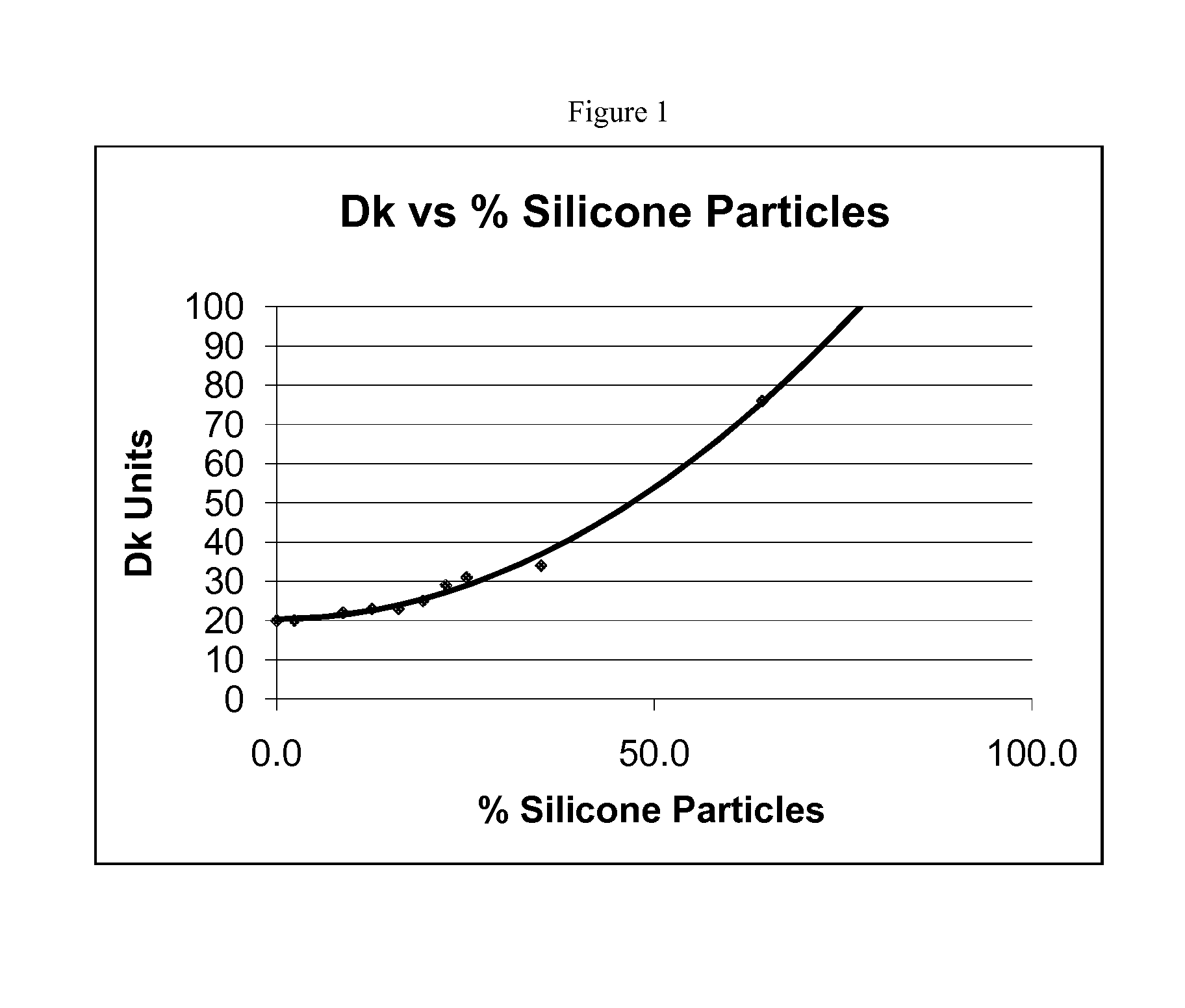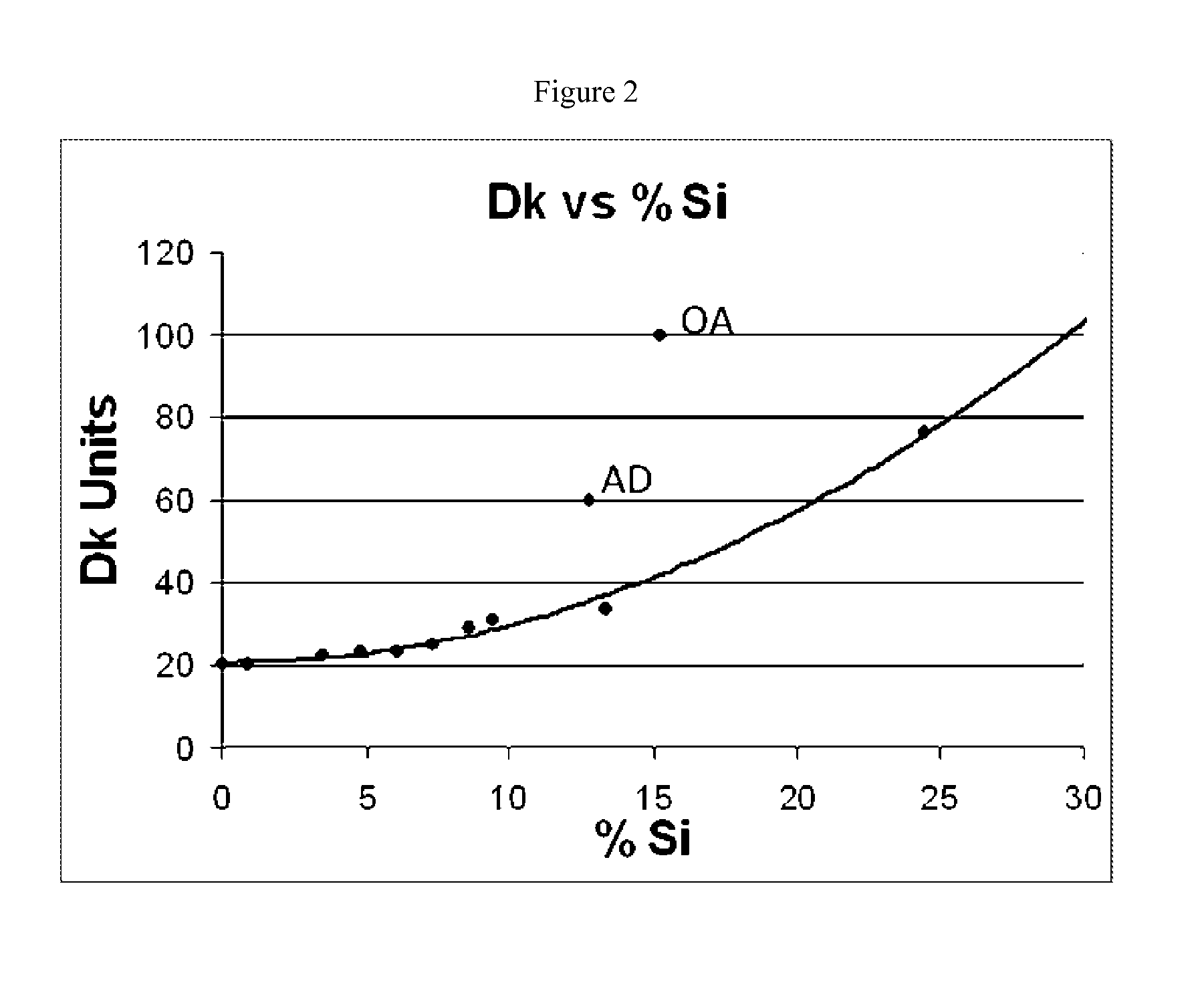Polymeric articles comprising oxygen permeability enhancing particles
a technology of oxygen permeability and polymer particles, which is applied in the field of polymer articles comprising oxygen permeability enhancing particles, can solve the problems of poor wettability and mechanical properties, difficult production, and insufficient oxygen permeability to maintain a healthy cornea during long-term wear of contact lenses, and achieve the effect of increasing the thickness
- Summary
- Abstract
- Description
- Claims
- Application Information
AI Technical Summary
Benefits of technology
Problems solved by technology
Method used
Image
Examples
examples 1-11
[0105]Monomer mix comprising 94.90% HEMA, 1.94% MAA, 0.95% Norbloc, 1.33% Irgacure 1700, 0.77% EGDMA, 0.09% TMPTMA, and 0.02% Blue HEMA (w / w) in BAGE diluent (52:48 monomer:diluent) herein referred to as reactive monomer mix (RMM) was prepared and used for Examples 1-11.
[0106]In the preparation of examples 1-10 the desired mass of Si microparticles was added to an amber scintillation vial followed by addition of etafilcon RMM (10 g). The scintillation vial was capped and rolled for 2 hours prior to being degassed in vacuo (10 minutes) and used to prepare lenses. Levels of microparticles and RMM employed for each formulation are listed in Table 1, below. Lenses were then prepared for each example by dosing each Si microparticl monomer mix into separate front curves via pipette.
[0107]Example 11 in Table 1 was prepared by suspending half of the mass of the microparticles required in 2.4 g ethylene glycol and the other half in 5.2 g of monomer mix without BAGE. The mixture was then furt...
examples 12-15
Preparation of Siloxane Nano-Particles via Free Radical Micro-Emulsion Polymerization of OHmPDMS and SiMAA DM
[0114]Water-soluble initiator, VA-044, was purchased from Wako Specialty Chemical Company and was also used as received.
[0115]Each of the particle dispersions, having the compositions listed in Table 3, were made as follows. Water and DBS were added to a 1 L, 3-necked, jacketed reaction flask, equipped with a mechanical stirrer and thermal probe. The water and DBS were heated to 44° C. and stirred under a nitrogen blanket until a transparent microemulsion was formed. After 30 minutes of stirring at 300 rpm under nitrogen, an aqueous VA-044 solution (200 mg in 1 mL DI water) was added by syringe and allowed to mix. Both OHmPDMS and SiMAA DM were blended together and the resulting mixture was added drop-wise to the microemulsion while stirring at 300 rpm. After all of the silicone mixture was added (about 3-4 hours), the addition funnel was removed and the flask was sealed with...
PUM
| Property | Measurement | Unit |
|---|---|---|
| particle size | aaaaa | aaaaa |
| particle size | aaaaa | aaaaa |
| particle size | aaaaa | aaaaa |
Abstract
Description
Claims
Application Information
 Login to View More
Login to View More - R&D
- Intellectual Property
- Life Sciences
- Materials
- Tech Scout
- Unparalleled Data Quality
- Higher Quality Content
- 60% Fewer Hallucinations
Browse by: Latest US Patents, China's latest patents, Technical Efficacy Thesaurus, Application Domain, Technology Topic, Popular Technical Reports.
© 2025 PatSnap. All rights reserved.Legal|Privacy policy|Modern Slavery Act Transparency Statement|Sitemap|About US| Contact US: help@patsnap.com



